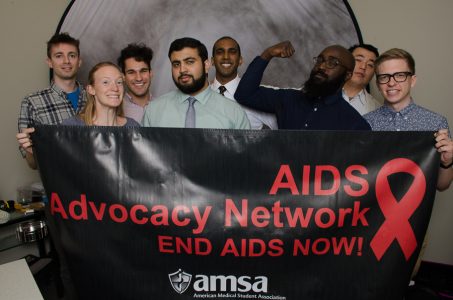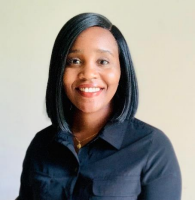By: Abiola Ogunbiyi, MS III—Trinity School of Medicine
Activate advocacy from within
As an AMSA summer intern, I was truly able to utilize my voice and activate advocacy from a place of knowledge and excitement. Over the past few months, I have learned so much about syringe service programs (SSPs), harm reduction and the dangerous effect of misinformation about these critical public health interventions. Mostly, I learned about the genuine power of advocacy. The best part of this internship experience was being able to engage with AMSA members, chapter leaders, and allies from all over the nation. Wherever I spoke to students, from Florida to Texas, Michigan and Alabama, they were passionate and excited to advance this cause through education and advocacy. Allies such as Mary Beth Levin, MPH, Associate Professor at Georgetown University School of Medicine, Dr. Chanelle Diaz, co-founder the Florida Needle Exchange Initiative, and Zach Ford, Program Manager, Sector Transformation and Syringe Access at AIDS United, embraced the idea of students standing up for what they believe in.

AMSA, its AIDS Advocacy Network (AAN) and associated Steering Committee is on a mission to build awareness and support for SSPs among medical trainees, physicians and policymakers all while supporting ongoing educational and advocacy opportunities for people who inject drugs (PWID) to live healthier lives. A generous grant from AIDS United—an organization that continuously “supports community-driven responses to the HIV epidemic around the country that reach the nation’s most disproportionately affected populations, including gay and bisexual men, communities of color, women, people living in the deep South and people living with HIV/AIDS” – supported my experience last summer (1). Having donated more than $104 million to local communities, AIDS United works to invest in syringe access programs, increase access to care, and prevent HIV (1).
But what are syringe service programs?
I’m glad you asked! Syringe service programs were created to provide PWID with new, sterile syringes in exchange for used syringes in order to reduce bloodborne pathogens such as HIV, Hepatitis B and C. While doing so, SSPs are able to target this specific population and educate them about risk reduction, drug counseling, mental health care and provide substance use treatment. The current policy, as written in the Consolidated Appropriations Act of 2016, states that “states and local communities, under limited circumstances, [have] the opportunity to use federal funds to support [specific] components of SSPs” (3). The specific components of SSPs include, but are not limited to, support staffing costs, mobile units, office space, testing kits, per diem items such as gas for use of company car. While it is still clearly written that no federal money can be used to purchase sterile syringes, the bill provides a starting point for efforts to reduce transmission of HIV/AIDs and other bloodborne pathogens by sustaining SSPs.
Now that I know what SSPs are, which states allow access to these programs?
SSPs have proven to be a cost-effective public health intervention. Approximately, 20 states, including the District of Columbia have authorized syringe exchange statewide per the Consolidated Appropriations Act of 2016. Two states, Connecticut and Indiana have limited authorization of SSPs in either one county or a limited area; whereas, 28 states do not prohibit SSPs (3). For example, Michigan allows the potential retail of syringes; however, there is no law that explicitly prohibits SSPs nor its provided services. There are currently eight SSP locations throughout the state according to NASEN.org (4). Another example can be seen in Austin, Texas. SSPs are acceptable through private funding and permission from local law enforcement. This example of having a collaborative relationship between SSPs and local law enforcement promotes the goals and efforts of the public health sector, crime management and social constructs (5).
Okay, what next?
Let’s work together to make sure that all 50 states and territories authorize syringe exchange statewide! Let’s further reduce the alarming rates of HIV/AIDS and Hepatitis B and C transmission amongst PWID!
AMSA chapters and AMSA members, together, let’s rally up!
Here’s YOUR Call to Action:
- Go to https://www.nasen.org to find a local SSP in your area. Get to know these organizations.
- Volunteer your time and/or services to SSPs, homeless shelters or health care clinics that provide care for PWID.
- Fundraise! Host a bake sale or table an event to educate your fellow community members and classmates about the need for SSPs.
- Use social media to engage with your local and state representatives and legislators. Tweet, Like or @ them about supporting the SSPs.
- Go to AMSA’s Syringe Exchange Advocacy webpage and access the Syringe Access Toolkit to get started!
Cited Resources:
- https://www.aidsunited.org/About.aspx
- Centers for Disease Control and Prevention. (2018, December 13). Syringe service programs. Retrieved on June 29, 2019 from https://www.cdc.gov/hiv/risk/ssps.html
- Public Health and Welfare Act, 42 USC sec 300ee-5 (2016). Retrieved on June 29, 2019 from https://www.gpo.gov/fdsys/pkg/USCODE-2009-title42/pdf/USCODE-2009-title42-chap6A-subchapXXIII-partA-sec300ee-11.pdf
- https://www.nasen.org
- https://fsph.iupui.edu/doc/research-centers/SSP_Report_20180516.pdf

